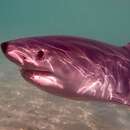Description of Carcharodon carcharias
provided by BioPedia
The great white shark, Carcharodon carcharias, is a large shark found in coastal surface waters in all major oceans. Largest individualshave exceeded 6 metres (20 ft) in length, and 2,268 kilograms (5,000 lb) in weight. This shark reaches maturity at around 15 years of age and can have a life span of over 30 years. It is the largest known living macropredatory fish and is one of the primary predators of marine mammals. It also eats a variety of other marine animals including fish, seals, and seabirds. It is the only known surviving species of its genus, Carcharodon, and is ranked first in a list of number of recorded attacks on humans. The IUCN treats the great white shark as vulnerable. As the antihero of Jaws, the great white shark is depicted as a ferocious man eater, they are not indiscriminate eating machines but ambush hunters, taking prey by surprise from below.They live in almost all coastal and offshore waters which have water temperature between 12 and 24 degrees C (54 and 75 degrees F), with greater concentrations in the United States (Atlantic Northeast and California), South Africa, Japan, Australia (especially New South Wales and South Australia), New Zealand, Chile, and the Mediterranean. One of the densest known populations is found around Dyer Island, South Africa where much shark research is conducted. It is an epipelagic fish, observed mostly in the presence of rich game like fur seals, sea lions, small whales, other sharks, sea turtles, and large bony fish species. In the open ocean it has been recorded at depths as great as 1,220 m (4,000 ft) Great whites may migrate considerable distances, from America or South Africa to Australia. Shark attacks most often occur in the morning, within 2 hours after sunrise, when visibility is poor. Although the great white is typically regarded as an apex predator in the wild, it is in rare cases preyed upon by the larger orca (also known as a killer whale).

